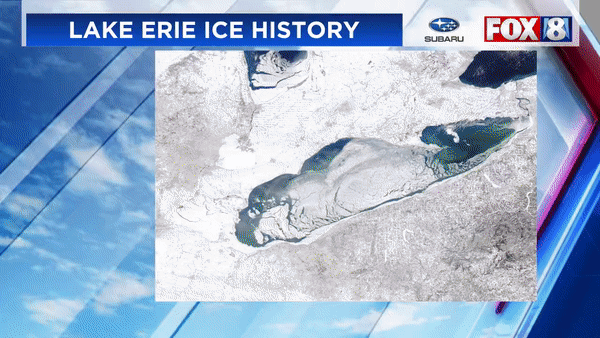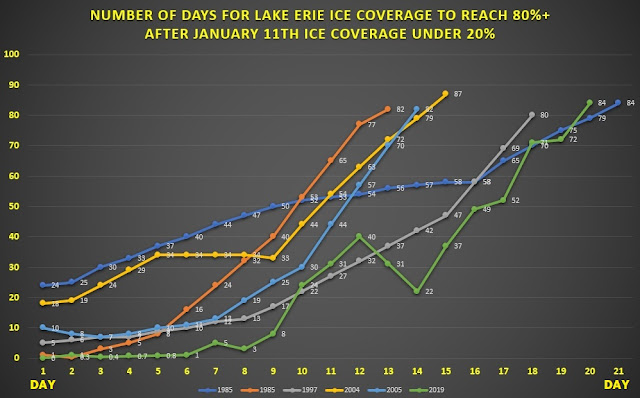So far no ice has developed on Lake Erie this winter through January 6, 2022.
The Great Lakes as a whole is void of significant ice.
There have been 12 winters (since 1972 when records began) where no Lake Erie ice was reported through January 5. Over those 12 winters, 6 ended up with at least 70% ice coverage for at least 3 weeks later in the winter!
Lake ice development is directly influenced by the duration of cold temperatures. The longer the temperatures stay cold, the faster and more expansive the ice coverage.
Last winter I did some research on the years where ice coverage increased rapidly and the temperature conditions that were present for this to happen.
For example, in 2019 the average temperatures over the period of Lake Erie ice coverage expansion (roughly a 2 week period) was WELL BELOW NORMAL across a large portion of the Great Lakes.
In similar years, the average amount of time of ice coverage expansion from 20% to 80% was roughly 2 weeks.
What are the shortest jumps from 20% to nearly 80% ice coverage?
2/7/1973 to 2/13/1973: 17% to 81% in 6 days
2/6/1995 to 2/11/1995: 16% to 80% in 5 days
1/17/1997 to 1/22/1997: 24% to 77% in 5 days
1/19/2005 to 1/24/2005: 24% to 82% in 5 days
2/4/2013 to 2/10/2013: 20% to 82% in 6 days
2/10/2016 to 2/15/2016: 0.7% to 79% in 5 days
Last year, we had VIRTUALLY NO ICE through the end of January. Then the early February cold developed and the ice coverage took off!
Look at the temperature vs normal from late January through mid February. It's no wonder the ice started forming this fast.
 |
Temperatures vs normal: January 25 to February 23, 2021
The issue this winter as in a few recent winters is the Lake Erie water temperature. The average water temperatures as of January 5 is still around 40 degrees.
While there are local regions in the mid 30s (western basin) the water temperature overall is well above average. When we compare this winter to other winters (2020-21, 2015-16, 2011-12 and 2006-07) when the water temperature was around 40 degrees on January 1st, it usually takes a month for the water temps to drop low enough to promote significant ice development. How fast the current lake water temperature drops will be key this winter!
|
So what's the take home message from this research?
* We still have some time to develop ice on Lake Erie
* Water temperature still needs to drop this month
* Ice coverage can significantly expand well into February
* Temperatures need to get significantly colder for at least 10 days (highs in the 20s) to develop significant ice (above 70%).
This has to occur between now and the first 2 week of February
* By mid March, lake ice begins to melt in most winters. Here is the weekly ice coverage for all winters from mid February to mid March:










